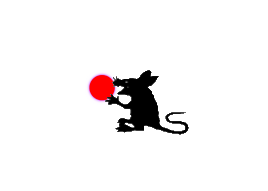Kevin Jerome Everson
Interview by Anna Hogg

Artist/filmmaker Kevin Jerome Everson was born and raised in Mansfield, Ohio. He has made eleven feature-length films and over 200 shorts. Everson’s films and artwork have been shown at the Sundance Film Festival, Berlin Film Festival, International Film Festival Rotterdam, Oberhausen Film Festival, Venice International Film Festival, Toronto International Film Festival, New York Film Festival, Ann Arbor Film Festival, as well as at the Museum of Modern Art, Whitney Museum of American Art, Smithsonian Museum of African-American History, The Tate Modern, Whitechapel Gallery, Andrew Kreps Gallery, and Centre Pompidou. Everson is recipient of The Guggenheim; Berlin Prize; Heinz Award in Arts/Humanities; Alpert Award in Film/Video; American Academy in Rome Prize and grants from Creative Capital, Ohio Arts Council and the NEA.. He is represented by Picture Palace Pictures and Andrew Kreps Gallery. Everson is Chair of the Art Department and a Professor of Art at University of Virginia, Charlottesville.
Sometime in the past year and a half, after the pandemic uprooted me and brought me from one coast to another, I found myself in the middle of a backyard summer screening with my undergraduate mentor Kevin Jerome Everson. Camping chairs and blankets were spread out evenly on the grassy lot, with familiar faces, masked though they were, smiling back at me. Several former classmates, fellow peers who had attended Kevin’s cinematography classes at UVA which we affectionately referred to as the Gutter, were in attendance. The film that would be the subject of that night’s screening was Don Siegel’s Invasion of the Body Snatchers from 1956. Fireflies started to compete for attention as the projector flicked on, and someone fiddled with the settings. “Oh hey Anna,” Kevin addressed me, as if no time had passed.
Sometime later, in the conversation that follows, I caught up with Kevin by Zoom to ask him about the work he made during the pandemic, and whether his approach to film has changed during this time.
Anna Hogg (AH):
Did you make any new work during the pandemic?
Kevin Jerome Everson (KJE):
Yeah, I shot some films. I took a bunch of gutter kids to Panama last January and I shot a film in the Canal. I made twenty or so films during the pandemic. A lot of them had fireflies. We were shooting — we had been filming for eighteen nights and didn't want to stop, so I bought a screen and projector and that's why we started doing outdoor screenings. Because we're out there catching fireflies and filming them. Me, Rachel Lane, Deidre Davie, Will Jones. I made three or four films with fireflies in them.
AH
So what are these firefly films?
KJE
Well, I want to make films based on summer. I have a body of work where the subject matter illuminates somehow or another. Fireflies are something I wanted to film for years. It’s funny, because everybody thinks you put them in jars and they light up. Everybody can remember that. But apparently fireflies don’t light up in captivity. So each night we only could film for about four minutes, and then the fireflies would not light up. So it took like 18 days to shoot — it was my longest film. Damn fireflies. (Laughs) It was all Super 8, 16 and Pocket Blackmagic.
AH
Did the pandemic shift your thinking about any projects at the time? For example, I remember hearing about a project you were making in Germany during your residency there. You were going to do a scene with cars, and then you had to change it up altogether, using tiny model cars instead.
KJE
Yeah, we shot some tiny cars. I bought a shitload of tiny cars. It’s amazing how detailed they are. That project ended up being in the show at Andrew Kreps, which got reviewed in Artforum. The basic idea behind the car films is that, when I was a teenager in high school, the army recruiter tried to entice a lot of Black American teenagers to join the army because it was a lot cheaper to buy a car in Panama — even less Germany — and ship it back. That was the point of departure for that project.
AH
Were there other projects that you couldn’t do because of the pandemic?
KJE
Yeah. I had an uncle who ended up shooting a guy in self-defense in 1984, in Columbus, Mississippi, and people were telling me different stories about it. We were going to reenact four different versions of that particular story, kind of like Rashomon. So I got actors together and was actually getting costumes for them. I was going to shoot it at a Hollywood type of studio in Berlin. I had to drop about $5,000 or $6,000 to get this set going, and I was going to shoot it all on Bolex and Super 8. But then, it was shut down. In fact I was going to shoot some army soldiers, too. I think the army was in its largest exercise in 25 years. So I was getting ready to move and groove, and then it shut down.
AH
Do you relate your practice as a filmmaker to other mediums? You work in sculpture and painting and photography as well.
KJE
I treat filmmaking like painting, only instead of the easel, the canvas, the brush and the paints, I have the tripod, the camera, the lens, and the film stocks. I see it as a form of composing. Both my degrees are in fine art photography, so when I do sculptures, it’s like I’m making prints, like I'm making three-dimensional photographs. The content of the work is about the kind of physicality of the medium and what the medium does, but for me, they kind of blur. They're all like little paintings, which is why I make so many films. People think, I mean some people wrote, that it comes from this “factory mentality” or something. But it's mostly because I come from a photographic background. So you have to make a body of work a year. The films are basically an illustration of the body work I made that year, but they're more akin to fine art, like prints and stuff. Because when I design for a film installation, I'm thinking about the gallery and how it affects the viewers walking in and out, as opposed to the theatrical kind of a theater setting. So I'm always thinking of the subject matter. I mean, a lot of my films are put into installation, but if I'm making something for an installation, I want the subject-matter to affect the light of the gallery, so to speak, more so than anything else.
AH
You show your films theatrically and also in gallery settings. Does the work translate easily from one to the other?
KJE
Some of them do, yes. But some things are better in the theater, and some are better in the gallery.
AH
What gets you excited to make a film?
KJE
It’s mostly I'm trying to exercise some kind of formal qualities. Like I'm working on this film about Eddie Hazel, who was a guitarist for the Funkadelic, and I’m looking at Caravaggio paintings, and paintings by Norman Lewis, a Black abstract painter from the 50s, and the contemporary abstract painter Stanley Whitney. I think the films are supposed to do these weird things with form and color, but I want to do it with sound. (Laughs) I’ll let you know next week if it works or not. Because we're shooting on Monday.
AH
Is this the project you’re going to Ohio to do?
KJE
Yeah, it's all about tonalities of color and sound, so to speak. So that’s the thing I was working on in the fall, when I was writing. I had been thinking about this Eddie Hazel project for three or four years, and then I decided to do it. It’s a form exercise. (Laughs) If it doesn’t work, just make it look good, you know? Because sometimes they fail. Sometimes you have to redo them.
AH
In those situations, do you ever try to just salvage what you have?
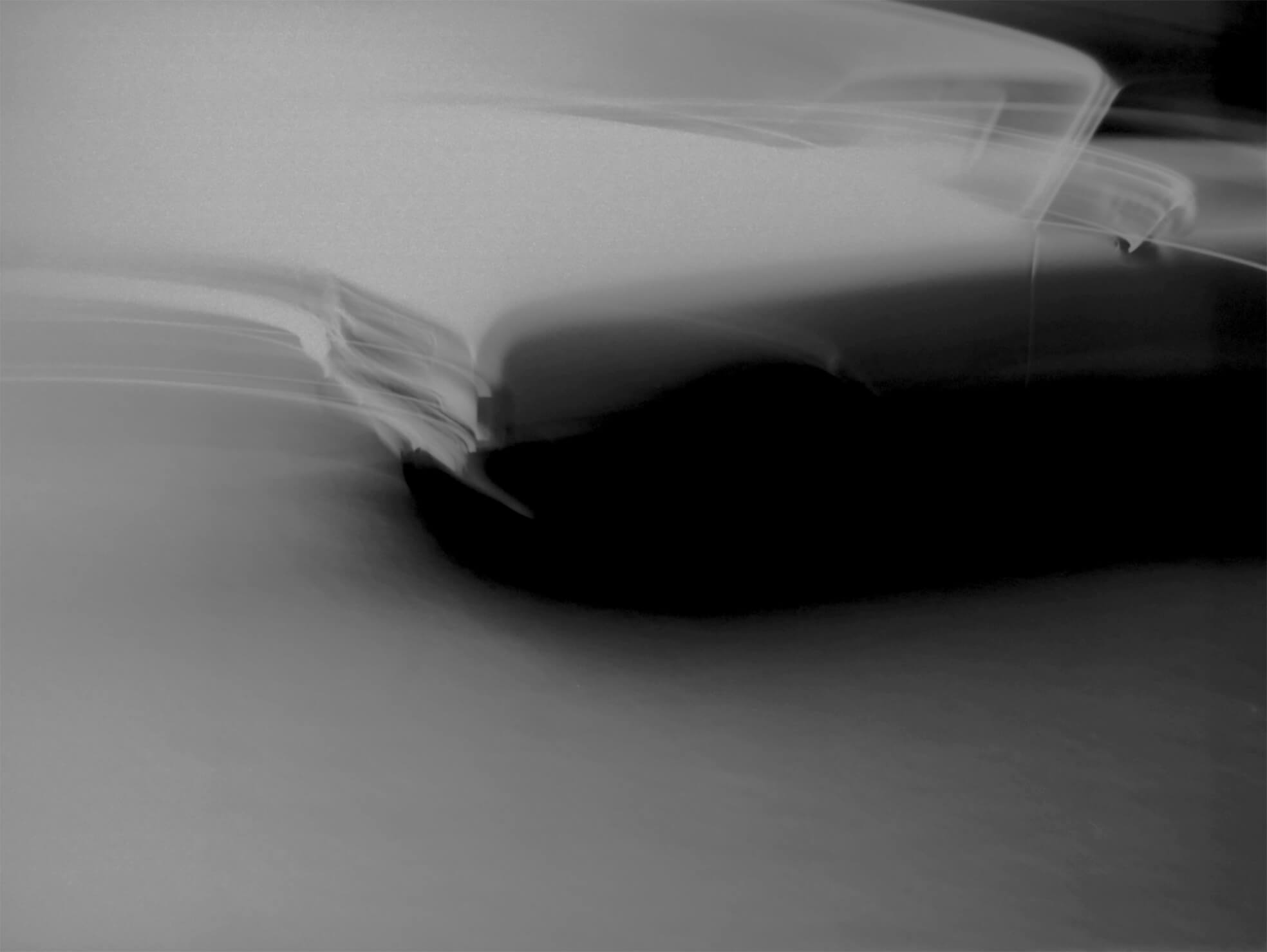
KJE
Oh yeah, all the time. I mean, they’ll work. But sometimes there are things in a film that only I'm dissatisfied with, because I wanted it to do something. They’re all experiments in a weird way, and what they may do is get me closer to doing something else. So that could be successful as well.
AH
I've always felt you have a very interesting interplay between sound and image. The sound adds something totally different to the image, but they work in unison in interesting ways.
KJE
Yeah, because I've been shooting with that Arri S camera, and the Arri S is not crystal sync. So I have to build the sound with the Bolex and the Arri S—I mean I'm usually recording sound, but I'm not recording sync sound. I know that the devices I'm going to use have to be built together, as opposed to crystal sync or HD camera or whatever. I can get both picture and sound at the same time, but I have to build. I've been shooting with those cameras that aren't sound sync for the past four or five years. But this summer is the first time it’s all sync sound—other than the stuff that me and Claudrena Harold are doing, the Black Fire films. I'll shoot some Bolex too, some hand cranks and some Super 8. But the two main things are going to be with the Aaton and the Ursa Blackmagic.
AH
So it's more about the material you're working with.
KJE
Yeah, it's more about the material. I like shooting silent films as well. In fact that's almost harder, deciding not to use sound.
AH
And these different materials—different cameras, synchronous or asynchronous sound—how do they affect the resulting films? Are they intertwined into the same film or different films?
KJE
I think the reason why I have a lot of films is because I shoot in variations — it’s like this thing I’m shooting next week. I’m going to have four or five versions. So the approach to the films will be different because the hi-con Super 16 won't look like the color Super 16, because the hi-con ASA is like 25 or 12 or something. I love that stuff. So anyway, those will be different, and then some of them will be handheld. I have so many films, because they're just basically variations with the same subject.
AH
With each staging or setup you have so many cameras. Do they function like different canvases?
KJE
Well I'm shooting them differently, but also when I'm editing I'm thinking these things are doing this, and this one’s doing this, even though they're the same kind of subject matter. So it's all slow-ass, boring shit. But it's funny, I got a bunch of these cars going around in circles, and now people want them. And then a few years ago I did all these bird watching films and now everybody wants that shit because of that guy, because that woman was calling the cops on that guy. (Laughs) So I remember that quote was, “How can birdwatching get political?” You know? Had nothing to do with that. Plus I was also making all these sculptural things I got to take to Ohio too. I made some meat tenderizers which I don't have here. And some wrenches that were made in my hometown. So, I'm going to film those hopefully.
AH
Those sculptural objects—you film them? Or are they put into action?
KJE
Lately I've been making things that don't function. But people are trying to function them, like these irons, for example — because they're made of rubber.
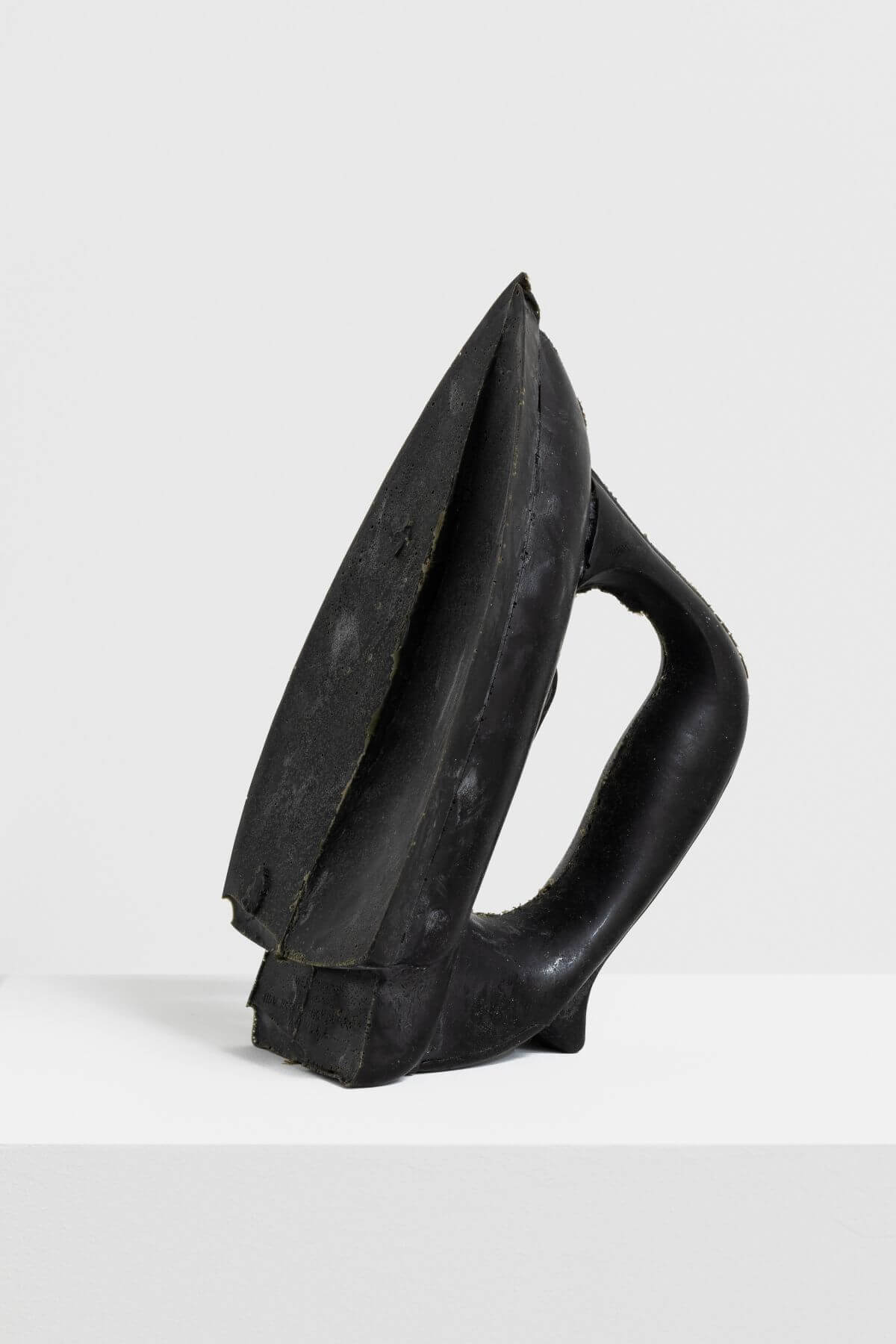

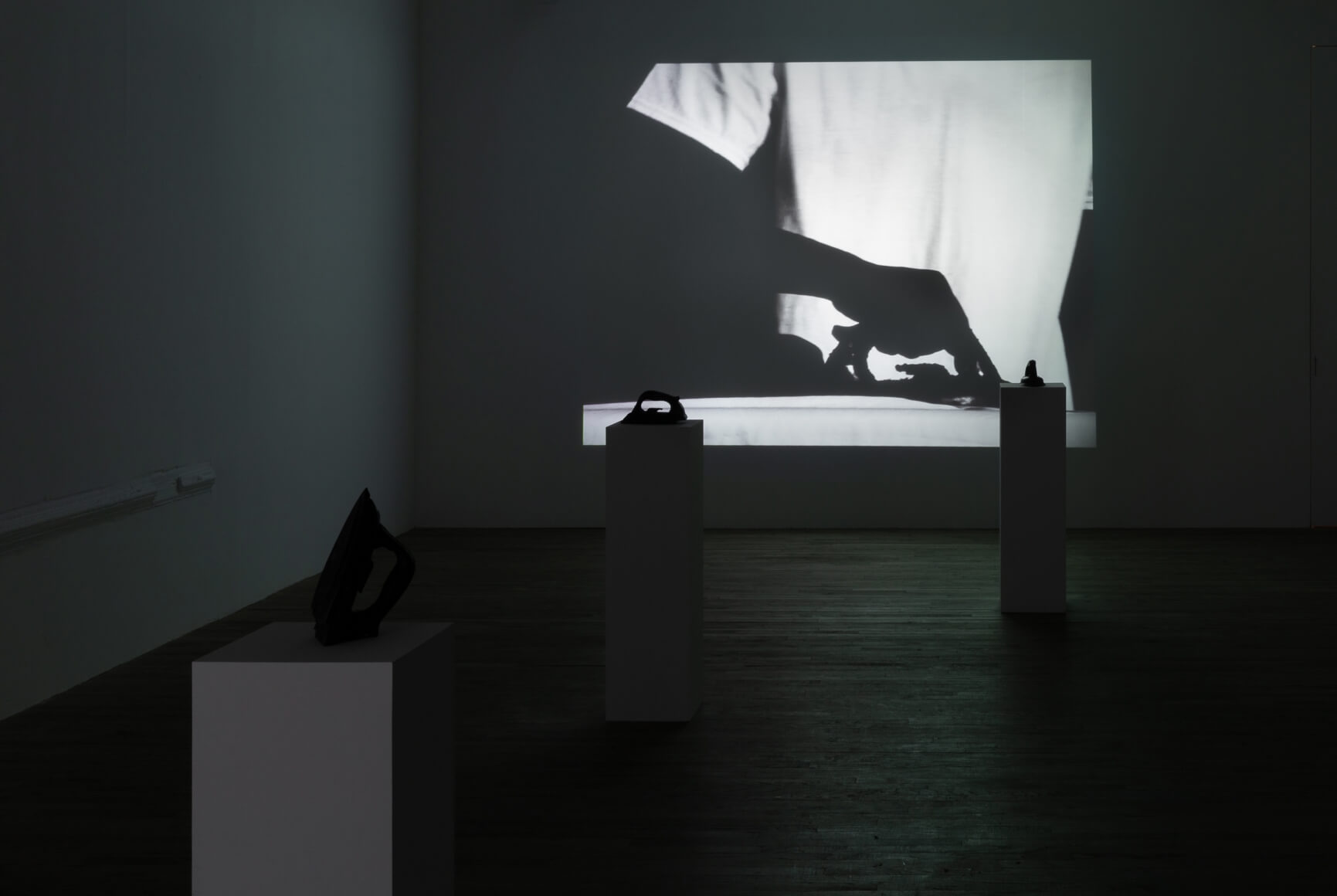
Above and bottom left: detail views of cast rubber irons. Bottom right: exhibition view of Kevin Jerome Everson, Westinghouse 1 (2019) at Andrew Kreps Gallery. Video, black and white, no sound; Six rubber irons.
AH
Can you talk about your approach to restaging, reperforming, and respeaking in your projects? Do you only use these methods in the Black Fire films?
KJE
No, I started them before. I mean this thing I'm doing this summer is a kind of restaging. It’s all based on a kind of misinformation — I thought that somebody said something to somebody, but it's not true. I think in the past, before I found a lot of found footage, I was making things that look like found footage. So I was restaging stuff then, too. I think you worked on Sugarcoated Arsenic, right? Well that was supposed to be found footage, as if Claudrena Harold had found it. I like that we use a story or a photograph or a piece of audio tape as a template, and then fill it in. I like that kind of restaging. And it plays with documentary because it’s a kind of fiction and documentary.

AH
Are you and Claudrena collaborating on other films?
KJE
Yeah, one is about Black hospital employees and the other one is about clothes. They're based on two photographs. The hospital employee is something I've been wanting to do for a while, but we kept putting it off because we had other, cooler things. This one is about a speakeasy south of town where hospital employees used to go. We're going to film in it. I actually wrote the script when I was in Berlin last year, because I thought we were going to shoot it last fall. It’s just a conversation based on two hospital employees, so a three or four minute film. And then the next one is about clothes.
AH
I’m also wondering about the role of the witness in these recreations, which feature in the Black Fire films, and another film, IFO, which I saw at Film Forum a few years ago.
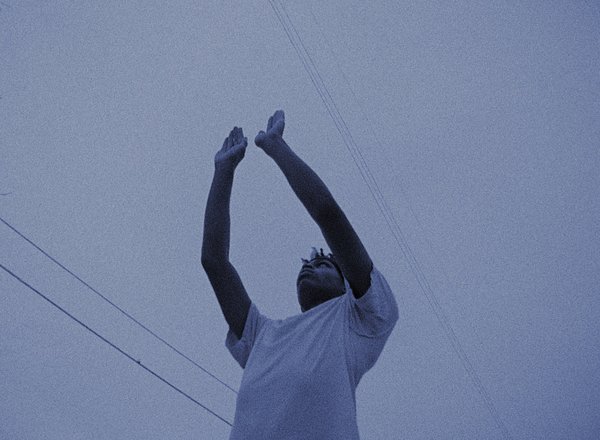
KJE
Yeah, it’s like a Caravaggio painting. There’s always somebody in the minor characters witnessing something. The representational image becomes a kind of eyewitness that’s based not on fact, but perspective, or perception. So for me it comes from photography but also from Caravaggio, and from the events that I'm trying to remember. The whole idea is that sometimes the eyewitness can become a griot, or storyteller. So it kind of tells their version of what they saw. There could be a factual but not really a truthful element in it.
AH
Is this how you’re thinking about the film about your uncle, which you said will be re-enacted Roshomon-style, based on different perspectives?
KJE
That’s my point of departure. I have relatives who tell long tales, and I like that. So I was going to film multiple times, based on eyewitness accounts of people who were there. All four, five, six of these accounts are completely different.
AH
So it's more about the act of storytelling rather than the truth of the story?
KJE
Yeah, more of the griot.
Kevin Jerome Everson’s monumental Park Lanes (2015), a mesmerizing eight-hour film that immerses viewers in a factory that produces bowling-alley equipment, is currently streaming exclusively at The Criterion Channel.
Anna Hogg holds an MFA in Film and Video from the California Institute of Arts and is currently teaching film and video at the University of Virginia. Her films have screened at the Kasseler DokFest, Chicago Underground Film Festival, and Big Sky Documentary Film Festival, and in 2017 she was awarded the Jury Prize for Best International Work at the WNDX Festival of Moving Image.
